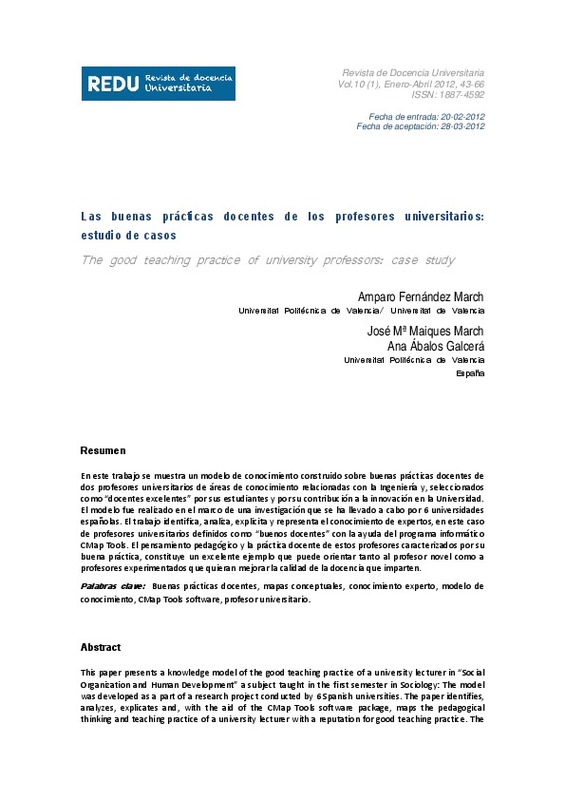Bain, K. (2006). Lo que hacen los mejores profesores universitarios. Valencia: PUV
Bolívar, A. (2002). "¿De nobis ipsis silemus?: Epistemología de la investigación biográfico‐narrativa en educación. Revista Electrónica de Investigación Educativa, 4(1). Consultado en: 18 marzo 2012. http://redie.uabc.uabc.mx/vol4n01/contenido‐bolivar.html
Cañas, A. J., Hill, G., Carff, R., Suri, N., Lott, J., Eskridge, T. et al. (2004). CmapTools: A Knowledge Modeling and Sharing Environment. En: A. J. Cañas, J. D. Novak & F. M. González (Eds.), Concept Maps: Theory, Methodology, Technology Proceedings of the First International Conference on Concept Mapping (Vol. I, pp. 125‐133). Pamplona, España: Universidad Pública de Navarra.
[+]
Bain, K. (2006). Lo que hacen los mejores profesores universitarios. Valencia: PUV
Bolívar, A. (2002). "¿De nobis ipsis silemus?: Epistemología de la investigación biográfico‐narrativa en educación. Revista Electrónica de Investigación Educativa, 4(1). Consultado en: 18 marzo 2012. http://redie.uabc.uabc.mx/vol4n01/contenido‐bolivar.html
Cañas, A. J., Hill, G., Carff, R., Suri, N., Lott, J., Eskridge, T. et al. (2004). CmapTools: A Knowledge Modeling and Sharing Environment. En: A. J. Cañas, J. D. Novak & F. M. González (Eds.), Concept Maps: Theory, Methodology, Technology Proceedings of the First International Conference on Concept Mapping (Vol. I, pp. 125‐133). Pamplona, España: Universidad Pública de Navarra.
Cooke, N.J. (1994). Varieties of Knowledge Elicitation Techniques. Internatinal Journal of Human‐Computer Studies, 41, 801‐849.
Denny, T. (1978). Storytelling and educatinal understanding, address delibered ay national meeting of International Reading Association. Houston, Texas. En Guba. E.G & Lincoln. Y.S. (1981). Handbook of Qualitative Research. Thousands Oaks, CA. Sage Publications.
Denzin, N.K. & Lincoln, Y.S. (eds.) (1994). Handbook of Qualitative Research. Thousand Oaks: Sage.
Dye, J.F., Schatz, I.M., Rosenberg, B.A. & Coleman, S.T. (2000). Constant Comparison Method: a kaleidoscope of data. The Qualitative Report, 4(1/2), www.nova.edu/ssss/QR/QR3‐4/dye.html
Fernández, A. (2002). "La carpeta docente como estrategia formativa favorecedora de una actitud innovadora en los profesores universitarios" Boletín de la Red estatal de docencia Universitaria. Vol.2 (3). Septiembre.
Fox, D. (1983). Personal Theories of Teaching. Studies in Higher Education, 8: 151‐163.
Gargallo, B. Fernández, MªA. et.al. (2005). En el horizonte del espacio europeo de educación superior. Perfiles de docencia y evaluación de los profesores universitarios. Comunicación presentada en el X Congreso Interuniversitario de Teoría de la Educación. Nuevos espacios y nuevos entornos de educación. Alicante, 11‐13 de abril de 2005.
González García, F.; Guruceaga Zubillaga, A.; Pozueta Mendía, E.; Porta Cuéllar, S. (2010). Una Aproximación al Conocimiento de una Profesora Universitaria, Agente de Buenas Prácticas Docentes, Utilizando Mapas Conceptuales. PROFESORADO. Revista de currículum y formación del profesorado. Vol. 14 (3), 117‐130
González, F. & Ibañez, F. (2000). Una aportación a la mejora de la calidad de la docencia universitaria: los mapas conceptuales. Pamplona: UPNA
Gow, L. & Kember, D. (1993). Conceptions of Teaching and Their Relationship to Student Learning. British Journal or Educational Psychology, 63, 20‐33.
Kember, D. & Gow, L. (1994). Orientations to Teaching and their Effect on the Quality of Student Learning. Journal of Higjher Education, 65, 58‐74.
Kember, D. (1997). A Reconceptualization of the Research into University Academics' Conceptions of Teaching. Learning and Instruction, 7, 255‐285.
Kember, D. (2001). Beliefs about Knowledge and the process of Teaching and Learning as a Factor in Adjusting to Study in Higher Education. Studies in Higher Education, 26 (2), 205‐221.
Marcelo, C. (1987). El pensamiento del profesor. Barcelona: CEAC.
Muradas, M. & Zabalza, M.A. (2006). Los mapas conceptuales como recurso para representar y analizar buenas prácticas docentes en la educación superior. Cañas, J. & Novak, (Eds.). Concept Maps: Theory, Methodology, Tehnology Proc. Of the Second Int. Conference on Concept Mapping. San José, Costa Rica.
Murray, K. & McDonald, R. (1997). The disjunction between lecturers' conceptions of teaching and their claimed educational practice. Higher Education, 33, 331‐349.
Quinlan, K.M. (2002). "Case Studies of Academics' Educational Beliefs about their Discipline: toward a doscourse on scholarly dimensions of teaching. Paper presentado al Congreso Anual de la Higher Education Research and Development Society of Australasia. Adelaide, 8‐11 Julio.
Oser, F. K. & Baeriswyl, F.J. (2001). Choreographies of Teaching: Bridging Instruction to Learning. En Richardson, V.: Handbook of Research onTeaching. AERA. Pág. 10311065.
Rodriguez, G.; Gil Flores, J. & García Jiménez, E. (1996). Metodología de la investigación cualitativa. Málaga: Ediciones Aljibe.
Samuelowicz, K. (1999). Academics' Educational Beliefs and Teaching Practices. Thesis. Griffith University. Australia.
Samuelowicz, K. & Bain, J.D. (2001). Revisiting Academics' Beliefs about Teaching and Learning. Higher Education, 41(3), 299‐325.
Sigel, I.E. (1985). A conceptual analysis of beliefs. En Sigel, I.E. (Ed.): Parental belief systems: the psychological consequences for children. Hillsdale: Erlbaum. 345‐ 371.
Singer, E.R. (1996). Espoused Teaching Paradigms of College Faculty. Research in Higher Education, 37, 659‐679.
Stark, S. et.al. (2002). Use of cognitive mapping to understand environmental characteristics that support social participation of individuals who have mobility impairments. Paper presented to the 130th Annual Meeting of APHA.
Zabalza Beraza, M.A. (1988). Pensamiento del profesor y desarrollo didáctico, Enseñanza, nº 4‐5, 109‐138.
[-]









